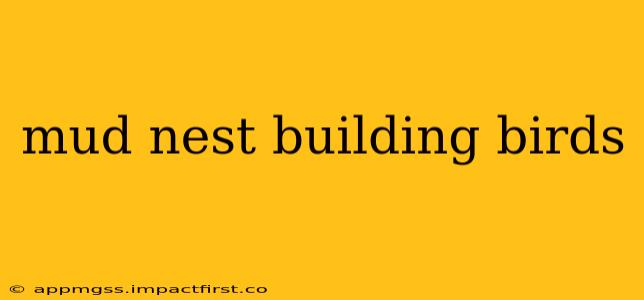Many bird species utilize mud as a key component in constructing their nests, showcasing remarkable ingenuity and adaptability. These nests, varying greatly in size, shape, and complexity, provide crucial protection for eggs and developing chicks. This comprehensive guide explores the fascinating world of mud nest building birds, delving into the techniques, benefits, and challenges involved in this intricate process.
What birds build mud nests?
Numerous avian species across various families employ mud in nest construction. Prominent examples include swallows (Hirundinidae family), which are arguably the most well-known mud nest builders, creating intricately sculpted nests often attached to cliffs, bridges, or human structures. Swifts (Apodidae family) also use mud, albeit often in conjunction with other materials, to build their nests. Other species, like some species of wrens, ovenbirds, and hornbills, incorporate mud into their nests, albeit often less prominently. The specific composition and structure of the nest vary greatly depending on the species and its environment.
How do birds build mud nests?
The nest-building process is a complex undertaking requiring skill, coordination, and often teamwork. Birds typically collect mud, often using their beaks and feet, from moist soil near water sources. They then meticulously shape and layer the mud, often mixing it with saliva or other binding agents to enhance its structural integrity. The process can be lengthy and laborious, with birds making numerous trips to gather materials and carefully constructing the nest over several days or even weeks. Some species also incorporate twigs, grasses, feathers, or other materials to reinforce the structure and provide insulation or camouflage.
What materials do birds use besides mud to build nests?
While mud forms the foundation of many nests, birds often incorporate other materials to improve structural integrity, insulation, or camouflage. These supplementary materials can include:
- Saliva: Many birds mix saliva with mud to act as a binding agent, increasing the strength and durability of the nest.
- Twigs: These provide structural support and reinforcement, particularly in larger, more complex nests.
- Grasses: These offer insulation and cushioning for the eggs and chicks.
- Feathers: These provide warmth and insulation.
- Plant fibers: These help bind the mud and other materials together.
- Animal hair: This can add insulation and strength.
Why do birds use mud to build nests?
Mud offers several advantages as a nest-building material:
- Strength and Stability: Mud provides exceptional structural integrity, capable of withstanding harsh weather conditions and predation.
- Moldability: Its malleability allows birds to create diverse nest shapes and sizes to suit their specific needs and environment.
- Abundance: Mud is readily available in many habitats, particularly near water sources.
- Protection: A well-constructed mud nest provides excellent protection from the elements and potential predators.
What are some common shapes and locations of mud nests?
Mud nest shapes vary drastically depending on the species. Some, like swallow nests, are cup-shaped and attached to vertical surfaces. Others, like the nests of certain ovenbirds, are dome-shaped structures with a side entrance, offering increased protection for their young. Nest placement is also highly variable, ranging from cliffs and caves to tree branches, buildings, and even underground burrows. The choice of location is driven by factors such as predator avoidance, protection from the elements, and access to foraging grounds.
How long does it take birds to build a mud nest?
The time required for nest construction varies greatly depending on the species and the complexity of the nest. Some simpler nests might take only a few days to build, while more complex structures may require several weeks of diligent work. Factors like weather conditions, material availability, and potential disturbances can also significantly influence the overall construction time.
Are mud nests effective at protecting eggs and young birds?
Yes, well-constructed mud nests provide significant protection for eggs and chicks. The robust structure offers protection from rain, wind, and extreme temperatures. The enclosed design of some mud nests also offers a degree of camouflage and protection from predators. However, it's important to note that no nest provides foolproof protection, and predation remains a significant threat to many bird species.
What are some threats to mud nests?
Despite their protective qualities, mud nests face various threats:
- Predation: Predators such as snakes, squirrels, and other birds actively seek out nests and their contents.
- Weather: Heavy rainfall, storms, and extreme temperatures can damage or destroy nests.
- Human disturbance: Human activities, such as building construction or removal of nesting sites, can significantly impact mud nest populations.
- Parasites and diseases: Nests can become infested with parasites or disease-carrying organisms, harming the eggs or chicks.
By understanding the remarkable engineering and ecological significance of mud nests, we can better appreciate the diversity and resilience of avian life and the importance of protecting their habitats.
